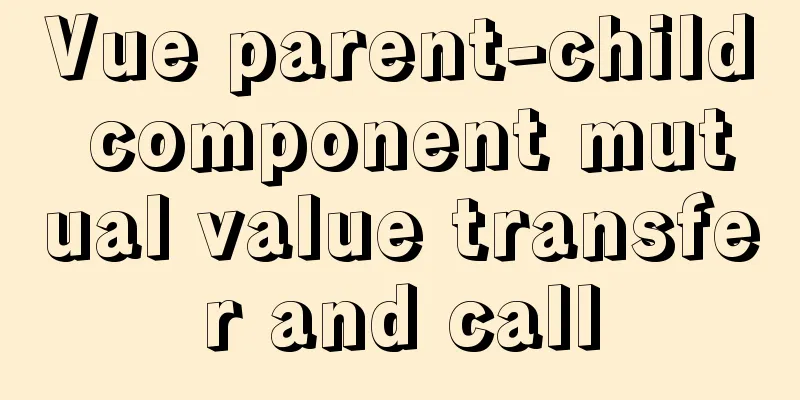Vue parent-child component mutual value transfer and call

1. Parent passes value to child componentParent component:
<template>
<div>
<p class="father">Father component</p>
<child :sid="id"></child>
</div>
</template>
<script>
import child from './child'
export default {
components:
child
},
data() {
return {
id:'1234' // value passed from parent component to child component}
}
}
</script>Subcomponents:
<template>
<div>
<p class="child">Child component</p>
<p class="child">The value of the parent component received is: {{ sid }}</p>
</div>
</template>
<script>
export default {
props:{
sid:{
type:String,
default: '0'
}
},
// props:["sid"],
data() {
return {
}
}
}
</script>illustrate: ①sid is the value to be passed in the subcomponent. Remember that the sid before "=" must be consistent with the variable name to be accepted in the subcomponent. ② Use props in child components to accept incoming values. You can write them as object types, specify types and default values, or write them directly as strings. ③It can be used directly in the subcomponent, or it can be accessed using this.sid in the function 2. Child passes value to parent componentParent component:
<template>
<div>
<p class="father">Father component</p>
<p class="father">Receive the value of the child component: {{childSid}}</p>
<child @passValue="parentPassValue"></child>
</div>
</template>
<script>
import child from './child'
export default {
components:
child
},
data() {
return {
childSid:'' // Receive the value of the child component}
},
methods: {
parentPassValue(data) {
this.childSid = data;
}
}
}
</script>Subcomponents:
<template>
<div>
<p class="child">Child component</p>
<button @click="valueClick">Pass value</button>
</div>
</template>
<script>
export default {
data() {
return {
}
},
methods: {
valueClick() {
this.$emit('passVaule',19)
}
}
}
</script>illustrate: ① Give a method in the child component to trigger $emit. The first parameter is the function name ('passVaule') that the parent component introduces into the child component binding, and the second is the value to be passed (19) ②Bind a function in the parent component, call the function bound in the parent component, and perform a receiving operation on the value in it 3. The child calls the method in the parent componentParent component:
<template>
<div>
<p class="father">Father component</p>
<child @funValue="parentFunValue"></child>
</div>
</template>
<script>
import child from './child'
export default {
components:
child
},
data() {
return {
}
},
methods: {
parentFunValue() {
console.log('The function in the parent component is called');
}
}
}
</script>Subcomponents:
<template>
<div>
<p class="child">Child component</p>
<button @click="funClick">Call parent component method</button>
</div>
</template>
<script>
export default {
data() {
return {
}
},
methods: {
funClick() {
this.$emit('funVaule')
}
}
}
</script>illustrate: ①This is similar to passing values from child to parent, but instead of passing values, the bound function of the parent component is called. 4. Parent calls methods in child componentsParent component:
<template>
<div>
<p class="father">Father component</p>
<button @click="childClick">Call child component method</button>
<child ref="mychild"></child>
</div>
</template>
<script>
import child from './child'
export default {
components:
child
},
data() {
return {
}
},
methods: {
childClick() {
this.$refs.mychild.testNum(1)
}
}
}
</script>Subcomponents:
<template>
<div>
<p class="child">Child component</p>
</button>
</div>
</template>
<script>
export default {
data() {
return {
}
},
methods: {
testNum(data) {
console.log('The method in the child component is called:', data);
}
}
}
</script>illustrate: ① In the parent component, write ref = "mychild" in the imported child component. Mychid is the instance name defined for itself. ② Write this.refs.mychild.testNum() in the function, "testNum" is the function name defined in the child component ③The child component defines a function and lets the parent component call it ④This method can also pass values. Pass the value in the brackets and the subcomponent will receive it. The above is the details of the mutual value transfer and calling of Vue parent-child components. For more information about the value transfer and calling of Vue parent-child components, please pay attention to other related articles on 123WORDPRESS.COM! You may also be interested in:
|
<<: Tutorial on installing and configuring remote login to MySQL under Ubuntu
>>: VMware WorkStation 14 pro installation Ubuntu 17.04 tutorial
Recommend
Detailed explanation of MySQL combined index and leftmost matching principle
Preface I have seen many articles about the leftm...
Detailed steps for configuring mysql8.0.20 with binlog2sql and simple backup and recovery
Table of contents First step installation Step 2:...
Vue.js implements simple folding panel
This article example shares the specific code of ...
Detailed explanation of the use of $emit in Vue.js
1. Parent components can use props to pass data t...
Docker implements cross-host container communication based on macvlan
Find two test machines: [root@docker1 centos_zabb...
Vite2.0 Pitfalls
Table of contents Vite project build optimization...
Vue implements countdown function
This article example shares the specific code of ...
How to manage large file uploads and breakpoint resume based on js
Table of contents Preface Front-end structure Bac...
Linux redis-Sentinel configuration details
download Download address: https://redis.io/downl...
Two ways to start Linux boot service
Table of contents rc.local method chkconfig metho...
Summary of Button's four Click response methods
Button is used quite a lot. Here I have sorted ou...
CSS to achieve Cyberpunk 2077 style visual effects in a few steps
background Before starting the article, let’s bri...
Small problem with the spacing between label and input in Google Browser
Code first, then text Copy code The code is as fol...
CSS3 flexible box flex to achieve three-column layout
As the title says: The height is known, the width...
JS realizes the card dealing animation
This article example shares the specific code of ...









